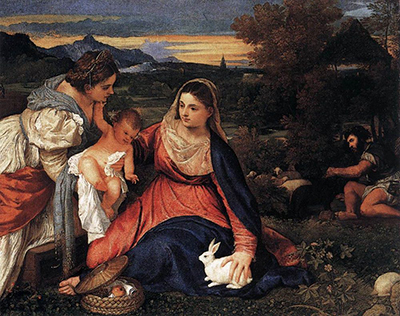The Madonna of the Rabbit is an oil painting by Titian. Titian was one of the founders of the Venetian School of Italian Renaissance painting.
Known for painting portraits, landscapes and scenes of religious subjects (particularly in this case) Titian inspired many artists during his own age and those who came after him. Always holding a passion for colour (something which became characteristic of the Venetian style), he was also known for using loose brushstrokes. Painted in 1530, it is now found within the Louvre, the largest art museum in the world.
Titian signed the painting 'Ticianus f.' and the painting is named after the small white rabbit which Mary is holding in her left hand. Not only does this rabbit symbolise fertility, the colour of its white fur represents innocence, purity, incarnation and Mary's virginity in particular. The rabbit is chosen to symbolise Mary's virginity due to the ability of the female rabbits and hares being able to be impregnated with a second litter whilst still being pregnant with a first. This gives the appearance of the ability to give birth to a litter without being pregnant in the first place. A parallel to Mary and the birth of Christ.
In 1529, Federico Gonzaga commissioned three paintings from Titian and it is very likely that one of them was The Madonna of the Rabbit. Federico II was ruler of Mantua from 1519 (starting as Marquis and later becoming Duke). The fact that the painting is quite small suggests that this commission was for personal enjoyment and not for public consumption.
In mourning for his late wife Celia who died during childbirth, Titian's paintings had a certain melancholic mood to them during this hard time. His third child, Lavinia, the product of this birth, was given over to his sister Orsa after Celia's death. This sad transaction is reflected in The Madonna of the Rabbit as Christ is being handed over to another woman, Saint Catherine of Alexandria.
In 1627 the painting was in the hands of Charles I, along with the rest of the Gonzaga Collection (artwork commissioned and possessed by the House of Gonzaga). After Charles I's execution, Louis XIV of France and cardinal Richelieu acquired it. Saint Catherine of Alexandria appears to be dressed as a maid of honour as she sits with Mary beside a basket filled with fruit. The apples within the basket represent the original sin and the grapes represent redemption of that sin.
Originally Mary had her eyes upon the shepherd in the background who could have possibly been intended as Federico II but could represent Titian's sadness due to the melancholic look of the shepherd. The shepherd takes strong influence from Giorgione, who founded the Venetian School along with Titian and who inspired him throughout his life as an artist. Titian's use of colour comes into play here with the orange strokes against the blue sky being a signature for Titian. Some of Giorgione's finest paintings included the likes of The Tempest, Sleeping Venus, Christ Carrying the Cross and Self-Portrait.




